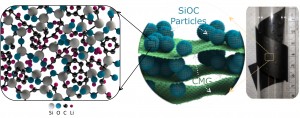Graphene and glass battery electrode may go orbital
A new battery electrode composed of graphene and glass could be used in aerospace applications. The new material is paper-thin and has a virtually perfect cycling efficiency. The materials used in the electrode are common, and therefore cost effective. The material also functions in cold temperatures, which means that it’s ideal for high-altitude and aerospace applications.
Researchers from Kansas State University have been working on batteries made from silicon and graphene, but early attempts were met with poor results. To correct problems including mechanical instability and low efficiency, the researchers developed a glass-like ceramic silicon oxycarbide electrode that’s surrounded by chemically modified graphene. The resulting glass based electrode is a high-capacity device that doesn’t require substantial mechanical support.
That’s good news because support elements don’t typically contribute to the efficiency of the system, but they can cause mechanical failure, and they increase the weight and size of the finished battery package. The glass based electrode weighs about 10% less than conventional battery components, and it can store enough electrons for practical use. As an added benefit, the glass-based electrode performs well at low temperatures, a feat that most batteries can’t achieve.
The new material was made by heating a liquid resin. Once heated, the resin breaks down into glass-like particles. The heated mixture, which contains oxygen, silicon and carbon, also self-arranges into a new 3-dimensional structure. This creates large storage spaces and smooth transportation pathways for lithium ions. The researchers intend to keep working on the process to make larger electrodes and perhaps develop mass production techniques. They also believe it may be possible to create electrodes from this material using a 3-D printing approach.
Most people don’t use glass to make space-age batteries, but there are still plenty of novel ways to use glass. Glassprimer™ glass paint can help you transform ordinary glass into a surface that’s both practical and decorative. Glassprimer™ glass paint comes in a virtual rainbow of colors and can be applied easily to glass, Plexiglas and other non-porous surfaces. The nanoscale surface bond ensures that the paint will not delaminate, even in the toughest conditions.
For more information about Glassprimer™ glass paint, please visit the rest of our site. If you’d like to purchase Glassprimer™ glass paint, please visit our online store .
Photo Credit: Kansas State University

